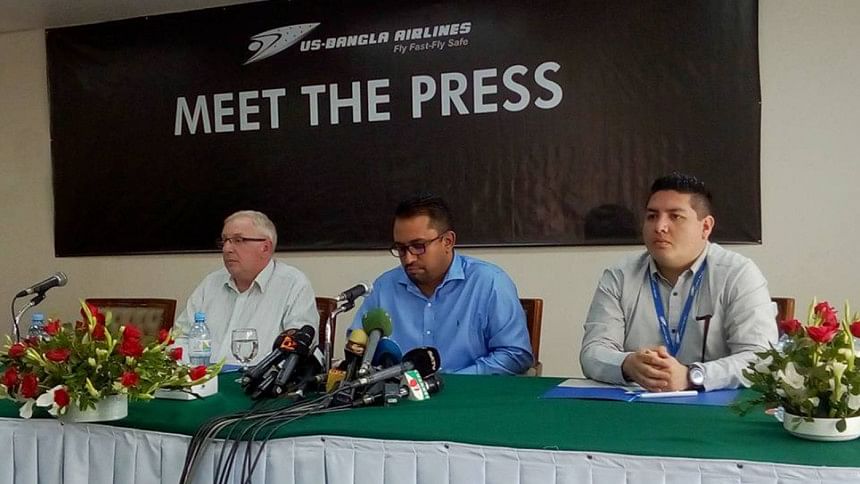Kathmandu Plane Crash: Questions over Nepal's probe

US-Bangla Airlines yesterday raised questions over the primary investigation report of the Nepalese authorities on the March 12 crash of its plane at Kathmandu airport that left 51 dead, 27 of them Bangladeshis.
The airlines also renewed its pledge to maintain high safety standards, 10 days after Nepal's probe cleared the US-Bangla plane of having any technical and mechanical problems. But the report skipped two vital issues related to the airport authorities, according to a statement of the airlines, read out by its Chief Executive Officer Imran Asif at a press briefing at Sonargaon Hotel.
Firstly, the clumsy communications of Nepal's Airport Traffic Control (ATC) with Pilot Abid Sultan, while giving permission to land, was not mentioned in the report, he said.
Secondly, he doubted the claim that a fire extinguishing team reached the spot within two minutes of the accident.
“We are doubtful about this information. Because, if the Nepal authorities had sent a fire team to the spot within just two minutes, then a lot of people would have been alive today,” the CEO said.
It is also impossible to go to the accident spot from the airport in such a short time, he added.
The US-Bangla Airlines expressed surprise at the omission of ATC's “confusing” instruction to the pilot.
In the audio, uploaded shortly after the accident by an unknown source, multiple people from the ATC were guiding the pilot and there was confusing communication and pauses in the exchange.
Nepal airport authorities had immediately transferred six of the controllers to unknown departments and remained tight-lipped about the reason.
“We don't know why they were transferred. But it's not usual to take such steps, if not found negligent,” he said.
The tower first cleared pilots of the US-Bangla Airlines to land, then asked them to go on hold elsewhere without cancelling the clearance, and at the same time it allowed another airline's plane to land, he said.
“In our understanding, it is a violation of international rule to allow another aircraft to land or fly without cancelling the landing clearance given to the previous plane.”
The real reason behind the crash can now be revealed only by experts, who would analyse the black box (sent to Canada) data and detailed probe report.
Flanked by two foreign aviation engineers, the US-Bangla CEO also briefed the press about the airlines' strict maintenance procedures.
Imran insisted that the airlines since its 2014 inception has been following safety and maintenance rules set by the International Civil Aviation Authority. “We never compromised on this,” he said, adding that the plane had undergone an extensive maintenance check (C check) recently.
He said 17 foreign engineers from Europe, Canadia and the USA check and maintain every aircraft of US-Bangla Airlines. No other airline has such a large number of foreign engineers for maintenance, he claimed, adding that it also has 62 local engineers who had been trained in London.
When asked about media reports claiming that the aircraft was not in proper alignment during landing, Imran said the probe report did not say anything like that.
He also brushed aside allegations that Capt Abid was fatigued. The latest medical report said to have found Abid in excellent condition.
According to international rules, a pilot can be on duty for 14 hours and may fly up to 11 hours a day. Had Abid returned to Dhaka from Nepal, his flying hours would have been less than seven hours that day.
“Besides, in the previous seven days [before the crash], he had a total of 15 hours of flying.”
“Capt Abid was completely sound mentally and physically. The allegations of sending him forcibly or him being fatigued are absurd.”
On the allegations that it was the first ever flight of co-pilot Prithula Rashid to Nepal, Imran said there was no breach of ICAO or Civil Aviation Authority of Bangladesh's rules in the case of Prithula.
“She was very successful in her two year service in US-Bangla Airlines. She was trained as a pilot from Arirang Aviation and had experience of flying 400 hours.”
Asked who was actually flying the aircraft during the accident, Imran said only the investigation could reveal this.

 For all latest news, follow The Daily Star's Google News channel.
For all latest news, follow The Daily Star's Google News channel. 






Comments